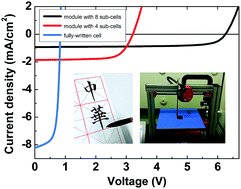当前位置:
X-MOL 学术
›
Mater. Horiz.
›
论文详情
Our official English website, www.x-mol.net, welcomes your feedback! (Note: you will need to create a separate account there.)
Writable and patternable organic solar cells and modules inspired by an old Chinese calligraphy tradition†
Materials Horizons ( IF 13.3 ) Pub Date : 2017-12-01 00:00:00 , DOI: 10.1039/c7mh00559h Lin Mao 1, 2, 3, 4, 5 , Bangwu Luo 1, 2, 3, 4, 5 , Lulu Sun 1, 2, 3, 4, 5 , Sixing Xiong 1, 2, 3, 4, 5 , Jiacheng Fan 1, 2, 3, 4, 5 , Fei Qin 1, 2, 3, 4, 5 , Lin Hu 1, 2, 3, 4, 5 , Youyu Jiang 1, 2, 3, 4, 5 , Zaifang Li 1, 2, 3, 4, 5 , Yinhua Zhou 1, 2, 3, 4, 5
Materials Horizons ( IF 13.3 ) Pub Date : 2017-12-01 00:00:00 , DOI: 10.1039/c7mh00559h Lin Mao 1, 2, 3, 4, 5 , Bangwu Luo 1, 2, 3, 4, 5 , Lulu Sun 1, 2, 3, 4, 5 , Sixing Xiong 1, 2, 3, 4, 5 , Jiacheng Fan 1, 2, 3, 4, 5 , Fei Qin 1, 2, 3, 4, 5 , Lin Hu 1, 2, 3, 4, 5 , Youyu Jiang 1, 2, 3, 4, 5 , Zaifang Li 1, 2, 3, 4, 5 , Yinhua Zhou 1, 2, 3, 4, 5
Affiliation

|
Scalable, patternable and affordable thin-film fabrication techniques for solution-processed organic photovoltaics are highly desirable. In this work, we report a new fabrication technique inspired by an old Chinese calligraphy tradition to fabricate organic solar cells and modules. The fabrication tool of “Maobi”, also called “Chinese ink brush”, has over 2000 years of history and has been widely used for writing and painting in old Chinese history. Using Maobi coating, the thickness of the active layers and the polymer electrodes could be tuned by optimizing the coating speed and substrate temperature. Solar cells based on Maobi-coated active layers (P3HT:ICBA, PTB7-Th:PC71BM and PBDB-T:ITIC) display comparable performance to the devices with spin-coated active layers. Among them, the cells with the Maobi-coated PBDB-T:ITIC active layer exhibit high power conversion efficiencies of 10.1%. Furthermore, based on the inherent advantage of the easy patterning of Maobi, we demonstrated Maobi-coated solar modules containing 8 sub-cells that exhibit a high open-circuit voltage (VOC) of 6.3 V and a high fill factor of 0.71. At the end, large-area solar modules (18 cm2) were demonstrated via a motor-driven computer-controlled automatic Maobi coating. The module displays VOC of up to 11.6 V and a power conversion efficiency of 6.3%.
更新日期:2017-12-01

























 京公网安备 11010802027423号
京公网安备 11010802027423号